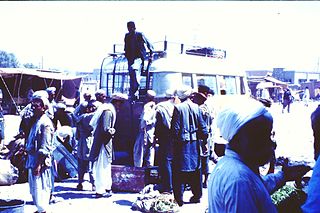
The Taliban insurgency began after the group's fall from power during the 2001 War in Afghanistan. The Taliban forces fought against the Afghan government, led by President Hamid Karzai, and later by President Ashraf Ghani, and against a US-led coalition of forces that has included all members of NATO; the 2021 Taliban offensive resulted in the collapse of the government of Ashraf Ghani. The private sector in Pakistan extends financial aid to the Taliban, contributing to their financial sustenance.
Events from the year 2007 in Afghanistan.
Chārdara District is one of the seven districts in Kunduz Province in northern Afghanistan. It is situated in the south-west part of Kunduz Province and has borders with Qalay-I-Zal District to the north-west, Kunduz District to the north-east, Ali Abad District to the south-east, Baghlan Province to the south and Samangan Province to the south-west.

Events from the year 2012 in Afghanistan.
The following lists events that happened in 2013 in Afghanistan.
The following lists events that happened during 2015 in Afghanistan.
The 2015 Kabul Parliament attack occurred on June 22, 2015, when members of the Taliban detonated a car bomb outside the National Assembly in Kabul then attacked the building with assault rifles and RPGs. Two civilians and seven Taliban died in the attack.
The following lists events that happened during 2016 in Afghanistan.

On May 8, 2016, two buses and a fuel tanker collided on a major highway, killing at least 73 people in the Muqur district, Ghazni Province, Afghanistan on the Kabul-Kandahar highway. More than 50 other people injured in the accident were taken to hospital in Ghazni Province. All three vehicles were set ablaze and completely engulfed in fire after the collision on the main road linking the capital, Kabul, to the southern city of Kandahar.

On June 20, 2016, at around 0600 AFT, a suicide bombing attack claimed to be conducted by the Taliban or the Islamic State in Khorasan Province (IS-KP) hit a convoy of Canadian embassy security guards en route to the embassy in Kabul. The attack took place in the ninth police district in the Benayi area, Kabul, Afghanistan. Thirteen Nepalese and two Indian contractors were killed in the attack.
On June 30, 2016, at least 40 people were killed and 50 people were wounded after two Taliban suicide bombers attacked police cadets returning from a graduation ceremony west of the capital city, Kabul. The attacks followed the Kabul attack on Canadian Embassy Guards and occurred during the Kunduz-Takhar highway hostage crisis. The attacks all occurred during the holy month of Ramadan.

On 3 September 2016, at least 38 people were killed and 28 were injured after a fuel tanker carrying two people collided with a passenger bus carrying over 60 people on the dangerous Kabul-Kandahar highway in the province of Zabul, Afghanistan. The accident comes after an even larger incident that occurred on the same highway in May.
Explosions in Kabul on September 5, 2016 killed over 41 people and injured 103 others in twin suicide bombings near the Afghan defense ministry. The Taliban claimed the first attack and said that their suicide bomber killed 58 people. Reportedly an army general and one district police chief were killed in the blast. Attacks lasted overnight with a siege and hostage situation. At least one person was killed and six injured in another attack on a charity CARE International building in Shāre Naw. The attack was claimed by the Taliban, with at least 3 of their attackers being killed and 42 hostages being rescued.
Events in the year 2017 in Afghanistan.
In May 2020, a series of insurgent attacks took place in Afghanistan, starting when the Taliban killed 20 Afghan soldiers and wounded 29 others in Zari, Balkh and Grishk, Helmand on 1 and 3 May, respectively. On 12 May, a hospital's maternity ward in Kabul and a funeral in Kuz Kunar (Khewa), Nangarhar were attacked, resulting in the deaths of 56 people and injuries of 148 others, including newborn babies, mothers, nurses, and mourners. ISIL–KP claimed responsibility for the funeral bombing, but no insurgent group claimed responsibility for the hospital shooting.
In a continuation of previous attacks by the Taliban in May and June, multiple clashes between Afghan security forces and the Taliban were reported. They carried out several attacks throughout Afghanistan, resulting in multiple fatalities on both sides. Both the Taliban and government forces have accused each other responsibility over the recent surge in violence across Afghanistan. The attacks come despite the signing of a peace deal with the U.S. in February that was intended to put an end to the war.
The October 2020 Afghanistan attacks were multiple attacks launched by insurgents including the Taliban and Islamic State of Iraq and the Levant – Khorasan Province in October 2020. The attacks left at least 243 people dead and 339 injured. 10 perpetrators were also killed in these attacks.
On 8 October 2021, an ISIS-K suicide bombing occurred at the Shia Gozar-e-Sayed Abad Mosque in the Afghan city of Kunduz. Over 50 people were killed, and another 100 were injured, but according to an estimate by the United Nations Assistance Mission in Afghanistan, more than 100 people were killed and wounded.




